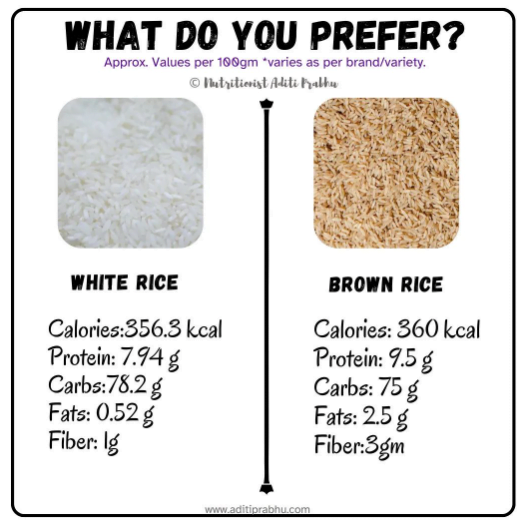White rice, a dietary staple consumed worldwide, holds a unique position in various cuisines. Praised for its simplicity and ability to complement a range of dishes, it’s important to understand the nutritional components that define white rice. In this article, we unravel the intricate tapestry of white rice nutrition facts to shed light on its impact on your overall health.
Basics of White Rice Nutrition Facts
White rice, the polished variant of brown rice, consists mainly of carbohydrates, providing a rapid and readily available energy source. However, its nutritional content extends beyond just energy. Let’s break down the key nutritional components in a typical serving of cooked white rice:
- Calories: A 1-cup serving of cooked white rice contains approximately 205 calories.
- Carbohydrates: White rice is carbohydrate-rich, providing around 45 grams of carbohydrates per cup.
- Protein: While relatively low in protein, white rice still contributes around 4 grams per serving.
- Fat: White rice boasts minimal fat content, with about 0.44 grams per cup.
- Fiber: Unlike its brown counterpart, white rice contains only about 0.6 grams of fiber.
Role of Carbohydrates
Carbohydrates are the primary macronutrient in white rice, serving as the body’s preferred energy source. The carbohydrates present in white rice are predominantly in the form of starch, which is quickly broken down into glucose during digestion. This can lead to rapid spikes in blood sugar levels, making white rice consumption something to be mindful of for individuals concerned about blood sugar control.
Fiber Discrepancy in White Rice Nutrition
One of the most significant disparities between white and brown rice is the fiber content. Brown rice preserves its bran and germ layers, which are abundant in fiber, vitamins, and minerals. On the other hand, the processing of white rice removes these layers, resulting in a loss of valuable nutrients, including fiber. As a result, the minimal fiber content in white rice doesn’t significantly contribute to digestive health or feelings of fullness.
Micronutrients and Enrichment in White Rice
Recognizing the nutrient loss caused by the removal of the bran and germ layers, many manufacturers enrich white rice with nutrients such as iron, thiamine, niacin, and folic acid. This enrichment attempts to address the nutritional deficiencies resulting from processing. However, the level of enrichment can vary between products and brands.

Image Source: Instagram @ricefacts
White Rice in the Context of a Balanced Diet
While white rice may not offer the same nutrient density as its brown counterpart or other whole grains, it can still play a valuable role in a balanced diet. Combining white rice with protein sources, vegetables, healthy fats, and other nutrient-rich foods can create a more well-rounded and satisfying meal.
Health Considerations with White Rice Nutrition Facts
- Blood Sugar Management: Due to its rapid digestion, white rice can cause spikes in blood sugar levels. Opting for brown rice or pairing white rice with fiber-rich foods can help mitigate this effect.
- Nutrient Diversity: Relying solely on white rice as a staple can lead to nutrient deficiencies over time. Incorporating a variety of nutrient-rich foods is essential for overall health.
- Gut Health: The low fiber content in white rice might not promote optimal gut health. Including high-fiber foods in your diet can support digestive well-being.
In Conclusion: Balancing White Rice Nutrition Facts
While white rice may not offer the same array of nutrients as its unrefined counterparts, it holds its own place in the culinary world. Like with all foods, it’s important to consume in moderation and include a variety in your diet. White rice can serve as a canvas for creative and nutritious meals when paired with nutrient-rich ingredients. Embrace a balanced diet to savor white rice’s versatility. While nourishing your body with a diverse range of nutrients.
Read More: Interesting Health Facts You Probably Didn’t Know
Facts About Rice
Certainly, here are some interesting facts about rice:
- Staple Food: More than half of the global population relies on rice as a fundamental dietary staple. It’s a primary dietary component in many Asian, African, and Latin American countries.
- Varieties: While there are thousands of rice varieties, they can generally be classified into two main types. Indica (long-grain) and japonica (short-grain).
- Cultivation: Rice is primarily cultivated in flooded fields known as paddies. The flooded conditions help control weeds, pests, and diseases, and they also aid in the growth of the rice plant.
- Origins: Rice cultivation is thought to have begun approximately 10,000 to 14,000 years ago in China’s Yangtze River valley.
- Nutritional Value: Rice is a good source of carbohydrates and provides energy to the body. It contains essential nutrients like B vitamins (thiamine, niacin, and riboflavin) and minerals (iron and magnesium).

Image Source: Instagram @ricefacts
Fun Facts About Rice
Here are some fun and lesser-known facts about rice:
- Rice and Birds: The saying “a rice bird never gets fat” reflects the belief that eating rice doesn’t lead to weight gain. This idea comes from the fact that birds that predominantly eat rice grains don’t become visibly fat.
- Rice Art: Some artists create intricate artworks using colored rice grains. Such transient artworks are frequently crafted during festivals and special events.
- Rice Paddy Art: In certain parts of Japan, rice paddies are transformed into large-scale art pieces by planting different varieties of rice that create colorful patterns when viewed from above.
- Rice and Music: In some cultures, rice is used to make musical instruments. For instance, the rainstick, a traditional percussion instrument, is often made from a long tube filled with rice or small beads.
- Rice Beer: Rice is used as a primary ingredient in various traditional alcoholic beverages, such as sake in Japan and rice wine in China and Korea.
- Rice in Space: Astronauts on the International Space Station have consumed rice-based dishes as part of their meals. Rice is a lightweight and easily storable food option for space missions.
These intriguing facts offer a glimpse into the intricate interweaving of rice with cultures, traditions, and daily life worldwide.










